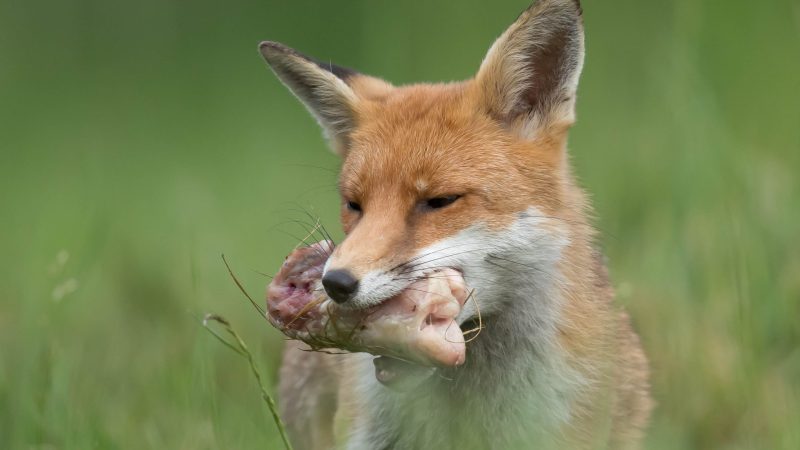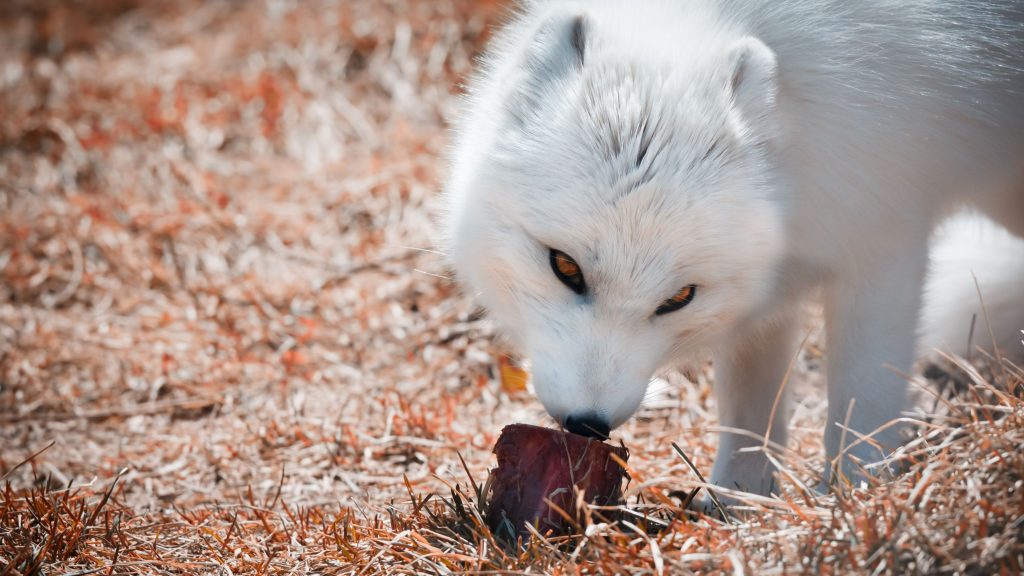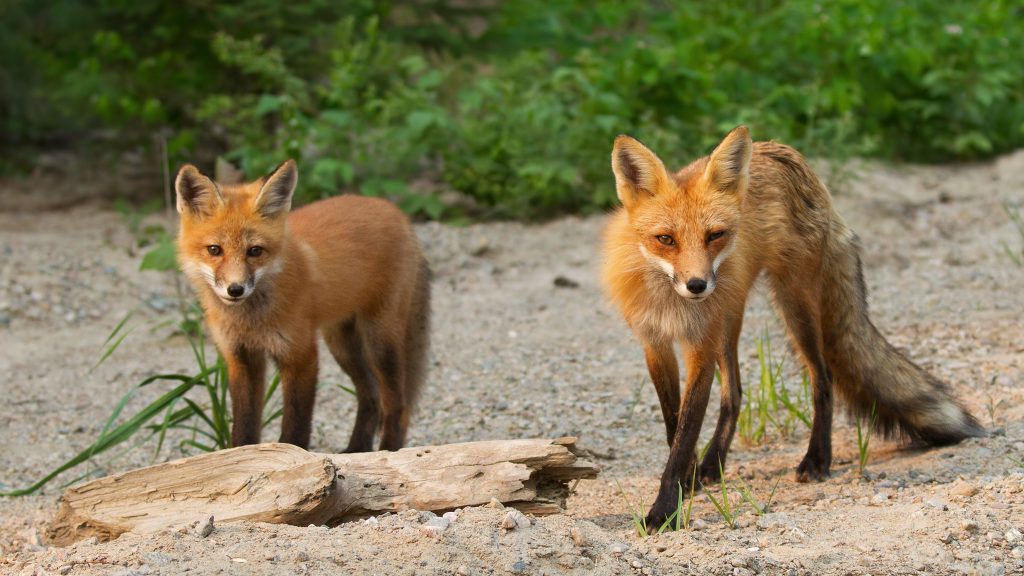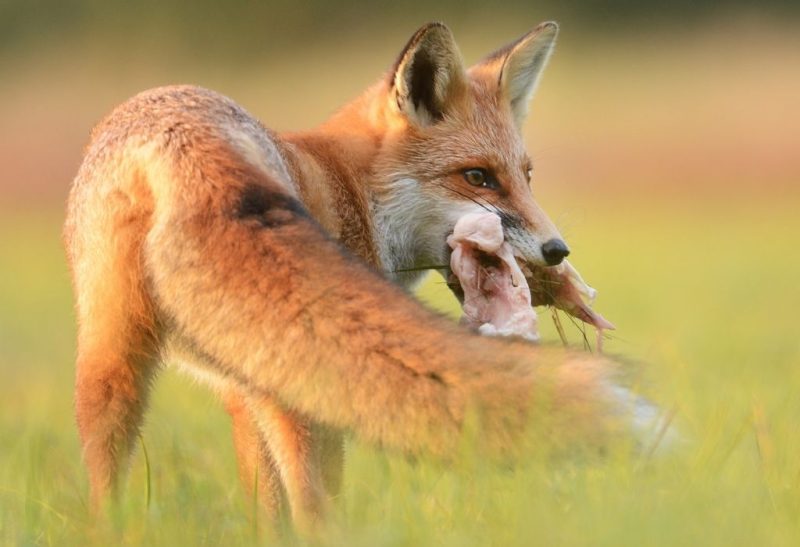Foxes are wild animals that belong to the Canidae family, and these animals have diverse diets. They’re expert hunters that chase wild birds and small mammals.
On top of that, they also consume various vegetation and fruits to complete their diet.
What do foxes eat? Most of the foxes are omnivores, so they eat plants and animals. In particular, they eat birds, rodents, hares, frogs, reptiles, earthworms, eggs, and voles. In addition, they also munch wild grasses, berries, mushrooms, and seeds. If they don’t find any meat sources to prey on, they start to forage for food to survive.
Since foxes exist in various parts of the world, their food sources can differ depending on what’s available at their home range or region. In this article, you’ll know more about the varieties of food they eat, along with their biology and ecology.
Table of Contents
Ecology | Fox Food Sources

Foxes live in different territories with corresponding marked boundaries. Each place has varied food sources, so it’s not surprising that foxes’ diets differ from each country.
In general, foxes can eat almost anything if no meat sources are available. Typically their diet includes but isn’t limited to the following:
- Birds
- Rodents
- Hares
- Lemmings
- Frogs
- Reptiles
- Eggs
- Berries
- Mushrooms
- Seeds
- Wild grasses
To know the ecology of foxes living from different continents, you can refer to the guide below:
Africa
Africa is known for its enormous wildlife diversity, and foxes are among those animals. Cape foxes are native to this country and known for their large pointed ears and silver-gray color.
Other species that live in Africa are the Pale fox and Rüppel’s fox. These fox species often prey on small animals, insects, and mice. They occasionally consume wild fruits, such as persimmons and wild apples, and eat carrion in farming sites.
Asia
Asia is a wide and varied continent. It’s home to seven fox’s species, such as the following:
- Corsac fox
- Arctic fox
- Rüppell’s fox
- Red fox
- Blanford’s fox
- Bengal fox
- Tibetan fox
Unlike other foxes’ species, these foxes in Asia usually prey on small rodents and are mainly carnivorous.
Australia
Red foxes were introduced to Australia during 1860’s for recreational hunting but became invasive species after 30 years. These foxes threaten and eat livestock that includes:
- Poultry
- Goat kids
- Lambs
North America
Foxes in North America typically live in grasslands and bushy areas. They feed on vegetation like wild grasses, roots, berries, and nuts.
Those foxes that live in the mainland areas of North America have an ample supply of vegetation, fruits, and small mammals. Moreover, there are four fox species in North America, and they are the following:
- Red fox
- Gray fox
- Arctic fox
- Kit fox
South America
The foxes in South America are omnivores and have a varied diet. Part of their diet consists primarily of birds, reptiles, mammals, bird eggs, carrion, and fruits, like Lithraea caustica and Cryptocarya alba.
In South America, there are at least six fox species, and that includes:
- Sechuran fox
- Hoary fox
- Pampas fox
- South American Gray fox
- Darwin’s fox
- Culpeo fox
Biology | Are Foxes Omnivores?
Not all foxes are omnivores. Some are carnivores, like the Tibetan fox. This fox primarily hunts for the meat of small animals like pikas, hares, and lizards.
The Tibetan foxes also occasionally feed on carcasses and aren’t known for vegetation or insect diets.
What Do Foxes Eat In the Wild?
In the wild, foxes eat diverse food. They primarily hunt for rodents, frogs, birds, earthworms, rabbits, and carrions.
On top of that, they also feed on fruits and berries.
What Do Baby Foxes Eat?
Baby foxes eat disgorged prey coming from their parents as well as fruits and rodents.
What Do Urban Foxes Eat?
Urban foxes have a very diverse diet that includes fruits and vegetables. Moreover, they also consume a wide variety of wild and domestic mammals and birds.
Fox Diets by Species

| Fox’s Species | Fox’s Diet |
| Bengal Fox (Vulpes Bengalensis) | Beetles, locusts, crickets, grasshoppers, termites, lizards, rodents, and ziziphus fruits. |
| Blanford’s Fox (Vulpes Cana) | Wasps, Coleopteransants, Orthopterans, and Isopterans. |
| Red Fox (Vulpes vulpes) | Rabbits, rodents, insects, birds, and fruits. |
| Swift Fox (Vulpes velox) | Grasshoppers, vegetations, and squirrels. |
| Fennec Fox (Vulpes velox) | Locusts, rodents, grasshoppers, leaves, small birds, lizards, fruits, and eggs. |
| Tibetan Fox (Vulpes ferrilata) | Rodents, black-lipped pika, rabbits, eggs, birds, lizards, and hares. |
| Kit Fox (Vulpes macrotis) | Rabbits, prairie dogs, rodents, kangaroo, rats, black-tailed jack rabbits, cotton tail rabbits, snakes, lizards, and insects ground-dwelling birds. |
| Arctic Fox (Vulpes lagopus) | Lemmings, fish, sea birds, and other marine life. |
| Cape Fox (Vulpes chama) | Gerbil mouse, beetles, pygmy mouse, termites, rabbits, scorpions, wild fruits, and small reptiles. |
Fox Food
Foxes’ diets are wide-ranging and primarily include eggs, birds, reptiles, mammals, and vegetation. In addition, they also consume various fruits and berries. But are these diets good for them? Read on below to find out!
Can Foxes Eat Grapes?
Foxes can’t eat grapes as this type of fruit is toxic to them. This fruit has a high tartaric acid and potassium bitartrate, which are known to cause renal failure, reducing the fox’s ability to urinate and discharge the toxins on its body.
Can Foxes Eat Dog Food?
Foxes can eat wet dog food that’s meat-based since most of the fox’s diet in the wild is meat protein—involving birds, small rodents, frogs, and insects. Since most dog foods are meat-based, this indicates that you can serve foxes tinned wet dog food, cooked meat, and raw meat.
Moreover, they can also eat up dog treats as they’re not picky eaters.
Do Foxes Eat Cats?
Foxes don’t eat adult cats but will nibble kittens. Adult cats tend to defend themselves, while kittens are helpless against their attacks.
Do Foxes Eat Eggs?
In general, foxes carry birds and chicken eggs away from their nest for their consumption. They carry the egg with their mouth, crushing the shell and eating its content.
Can Foxes Eat Chicken Bones?
Foxes eat a variety of foods, including chicken bones and lamb ribs. These types of bones are soft and can be eaten well.
However, cooked bones aren’t ideal for foxes as they can splinter fast when chewed. This can cause irreparable digestive tract damage, so it must be avoided at all costs.
Do Foxes Eat Fish?
As stated early in this article, foxes’ diet is diverse. This includes fish along with vegetables, fruits, frogs, and more.
Can Foxes Eat Chocolate?
Foxes can’t eat chocolate because it contains theobromine—a toxic substance to many animals, including foxes. Some signs of theobromine poisoning in animals include:
- Vomiting
- Seizures
- Diarrhea
- Muscle spasms
- Excessive thirst
In the worst-case scenario, theobromine or chocolate poisoning can lead to coma and even death due to the abnormal heart rhythm. However, these cases are quite rare.
The chocolate’s lethal dose for foxes and dogs is 240 to 500 mg per kilogram of the body weight.
Do Foxes Eat Potatoes?
In the wild, foxes forage and eat vegetables, including potatoes. So, if you’ve got a pet fox, you can add potato as part of their diet.
Do Foxes Eat Apples?
Part of the foxes’ diet are fruits, which include blackberries, blueberries, persimmons, and apples.
What Is Poisonous to Foxes?

A few things can be toxic to foxes, and they’re:
- Chocolate
- Grapes and raisins
- Macadamia and walnuts
- Onion
- Garlic
- Chives
Fox Habits
In general, foxes are active all year round and don’t hibernate. They’re typically nocturnal with some tendency to crepuscularity—which is about being active around dusk and dawn.
Mating happens once a year, commencing in early winter. In between March and May, the female foxes give birth to about four to five pups.
It’s also best to note that foxes live in small family groups of three to four.
Fox Habitats | How Do Foxes Hunt?
Foxes live in various habitats, including deserts, grasslands, mountains, and forests. They can also adjust well to human environments like suburban areas, farms—even in a large community.
They hunt by stalking their prey and pouncing on them. Since foxes have superb hearing skills and pouncing techniques, they can kill their prey quickly.
Foxes use their sharp hearing skills and listen to the moving animals underground to pounce on them the least they expect.
Fox Health | Diseases
One of the most known diseases linked with foxes is rabies. This virus typically attacks the nervous system of the person infected, then the brain, which can lead to death if not treated early.
Furthermore, humans and house pets, like dogs, can also catch Leptospirosis from foxes via their urine. If this disease isn’t treated early, this can lead to meningitis, kidney damage, liver failure, and respiratory distress.
Can Foxes Be Domesticated?
Unlike dogs, foxes can’t be domesticated. All species of fox are considered wild animals, including gray, arctic, fennec, and red foxes.
Although most species have adjusted well in areas where people are common, they still have similar needs as wild animals like regular preying. So, keeping them as pets can potentially be dangerous.
In some states in America, they’ll allow you to pet a fox, but it comes with law regulations. These laws differ from each state and vary depending on the fox species you want to keep.
Here are the states in America that allow foxes to be pets:
- Arkansas
- Indiana
- Florida
- Michigan
- Kentucky
- Missouri
- New York
- Nebraska
- North Dakota
- Ohio
- South Dakota
- Utah
- Oklahoma
- Wyoming
- Tennessee
Pet Fox Diet

Fox diet is similar to a dog’s diet. However, they can heavily benefit from the frequent eating of fresh meat.
In captivity, high-quality dog foods can make up their diet but providing foxes with whole fish or deer meat several times a week can keep their diet balanced.
Fox Food vs. Dog Food
Most foxes are omnivores, just like dogs. So, a balanced diet for a pet dog consisting of vitamins, minerals, fibers, and proteins will fit a pet fox.
How Foxes Have Adapted?
Foxes have adapted to their surroundings through their excellent sense of smell, hearing, and eyesight. The color of the fox fur also plays a significant part as it allows them to blend well with their surroundings.
Their compact bodies minimize the surface area exposed in the cold air. Foxes’ short legs, ears, and muzzles also conserve heat, preventing them from feeling cold.
Moreover, as non-rural development progresses, urban foxes have learned to adapt to living with humans. Urban foxes forage for food scraps on garbage bins and in the garden yard. These foxes make their dens on abandoned lots or structures, away from public disturbance.
Social Behavior of Foxes

Foxes typically live in social groups—comprising three to four adults. These are composed of vixens and dog foxes. In general, there’s only one vixen breed but can occasionally go up to three.
The cubs can be raised individually but can also be joined together in a large litter. Moreover, foxes are capable of being friendly and don’t usually pose threats to pets or humans.
Fox species, such as urban foxes, have learned to exist alongside humans. They communicate by making different sounds like short yapping barks, yelping, and growling.
In addition, they leave scent marks by urinating various areas to inform other foxes that there’s another fox present.
The Fox’s Role in the Animal Kingdom
Like all animals in the animal kingdom, foxes fulfill a greater purpose while advancing their own goal of reproduction and survival. As apex predators, they play a vital role in the food chain.
They keep the prey animal populations like rodents and rabbits under control, aiding the balance of nature. However, they can also be a threat to biodiversity by killing and hunting native wildlife.
Moreover, they have contributed to the extinction of many birds and small mammals species. They’re also known to threaten livestock, comprising goat kids, poultry, and lambs.
Summary
Foxes have a diverse diet that may differ based on their species and where they live. To see the respective diet of different fox species, you may refer to the table above.
Related: What Do Foxes Look Like? | With Pictures
List of Sources
Theobromine. National Library of Medicine.
Rabies. Centers for Disease Control and Prevention.
Fox. (2021). Queensland Government.
